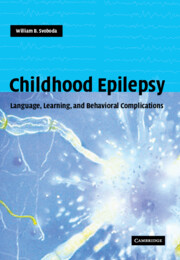Book contents
- Frontmatter
- Contents
- Preface
- Glossary
- 1 Looking ahead
- Part I Speech and language problems
- Part II Learning problems
- 12 Learning challenges
- 13 The development of learning
- 14 Learning difficulties
- 15 Learning problems with seizure types
- 16 Modifying factors
- 17 Transient cognitive impairments of epilepsy
- 18 Attention and alertness
- 19 Memory
- 20 Executive functioning
- 21 Academics
- 22 Antiepileptic medication effects
- 23 Effects of other therapies
- 24 Diagnosis
- 25 Gaining help
- 26 Frustrations of learning problems
- Part III Behavior problems
- Index
- References
19 - Memory
from Part II - Learning problems
Published online by Cambridge University Press: 26 October 2009
- Frontmatter
- Contents
- Preface
- Glossary
- 1 Looking ahead
- Part I Speech and language problems
- Part II Learning problems
- 12 Learning challenges
- 13 The development of learning
- 14 Learning difficulties
- 15 Learning problems with seizure types
- 16 Modifying factors
- 17 Transient cognitive impairments of epilepsy
- 18 Attention and alertness
- 19 Memory
- 20 Executive functioning
- 21 Academics
- 22 Antiepileptic medication effects
- 23 Effects of other therapies
- 24 Diagnosis
- 25 Gaining help
- 26 Frustrations of learning problems
- Part III Behavior problems
- Index
- References
Summary
“Memory” is a term for a very wide range of phenomena that involves the storage and retrieval of information (Eccles, 1966). Difficulties in memory and concentration may impede intelligence, leading to ineffective functioning (Dreifuss, 1983).
Types of memory
Memory differs, depending on the type of stimuli and the nature of processing. Most commonly referred to are auditory and visual memory, and, to a lesser extent, emotional memory. Other senses are also linked with memory. The different forms are mediated by different yet interrelated neuroanatomic systems. Some memories may be linked in time or place of their occurrence, but others are not. Memory may be stored as interpretations or as more basic habits (O'Keefe & Nadel, 1978; Baker & Joynt, 1986).
Memories are commonly divided into immediate, recent (short-term), and remote (long-term) types (Boller, 1996).
Memory processing
Memory is a complex process consisting of sequential stages involving orientation, attention, mental tracking, learning, retention, and retrieval of both recent and remote events. Memory efficiency varies greatly between individuals (Rapin, 1985). Remembering depends on the context and frequency of the learning experience, as well as curiosity and interest in what is occurring (Kinsbourne & Caplan, 1979). Memory begins with sensory input, which triggers an anticipatory evaluation, leading to the development of a short-term memory.
Perception
Perception is the detecting and distinguishing of differences in a sensation, which requires that the person remembers the stimulus long enough to perceive important details in order to organize and interpret the information into an appropriate response (Rumbaugh & Washburn, 1966; Rapin, 1985).
- Type
- Chapter
- Information
- Childhood EpilepsyLanguage, Learning and Behavioural Complications, pp. 289 - 309Publisher: Cambridge University PressPrint publication year: 2004



